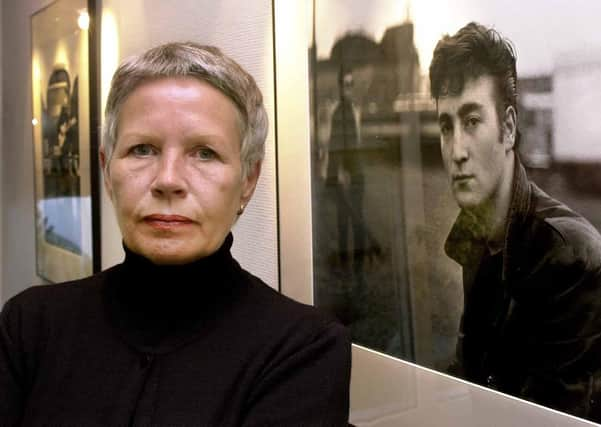Obituary: Astrid Kirchherr, photographer credited with shaping image of The Beatles


Sixty years ago a British band went off to Germany at the beginning of what they hoped would be the road to fame and fortune. There was John, Paul, George, drummer Pete Best and the bassist Stuart Sutcliffe from Edinburgh. They looked rough and ready and had fashionable DA hairstyles – short at the back, long at the front and slicked up and back. DA stood not for “district attorney”, but for “duck’s arse”.
In Hamburg the fledgling Beatles discovered another world, full of exotic characters, including soldiers, sailors, black marketeers, drug dealers, prostitutes and Astrid Kirchherr, an attractive young photographer and committed existentialist. Kirchherr fell in love with the sound of the band and, more personally, with Sutcliffe and was credited by many with creating the image that took the wider world by storm.
Advertisement
Hide AdAdvertisement
Hide AdKirchherr already had a boyfriend, musician and artist Klaus Voormann. And it was Voorman who first heard this new group and who took Kirchherr to see them. Before long she had broken up with Voormann and was engaged to Sutcliffe – though she and Voormann remained close and Voormann would later design the cover for the Beatles’ Revolver album.
In those seminal days in Hamburg, Kirchherr took naturalistic, monochrome photographs of the group, all shadows and leather and cheekbones. But more importantly, she also cut her new boyfriend’s hair in the style that was to become known the world over as the “moptop” or “Beatles cut”. The other Beatles followed suit, except for Best, who had naturally very curly hair that was not suited to the style. So they replaced him with Ringo. Sutcliffe even started wearing Kirchherr’s clothes, including a suit with no lapels, another element in the Beatles image.
Kirchherr downplayed her personal significance in the creation of the image. “Lots of German boys had that hairstyle,” she said. “All my friends in art school used to run around with this sort of what you call Beatles haircut. And my boyfriend then, Klaus Voormann, had this hairstyle, and Stuart liked it very, very much. He was the first one who really got the nerve to get the Brylcreem out of his hair and asking me to cut his hair for him.”
When George Harrison saw Sutcliffe’s hair he asked if she would cut his in a similar style. And Lennon and McCartney had theirs cut by one of Kirchherr’s “Exi” friends.
John, Paul, George and Ringo went on to fame and fortune, of course. Sutcliffe, who lived in Edinburgh’s Claremont Crescent and Chalmers Street as a young boy and met Lennon at art school in Liverpool, did not live to see their success. He died in Hamburg of a brain haemorrhage in April 1962, just six months before the release of the first single. He was 21.
Kirchherr was born in Hamburg in 1938. Her father was a salesman with the Ford car company. She was a toddler when the Second World War broke out and was evacuated to the Baltic Sea while her father delivered food and munitions for the army. Initially she studied fashion at college, but was encouraged to switch to photography and was already working professionally by the time she met the Beatles.
“Our post-war generation were struggling to escape the past and the burden of guilt we carried and to find a new way,” she said. One night Voormann took her to see the Beatles. “My whole life changed in a couple of minutes. All I wanted was to be with them and to know them.” She was immediately attracted to Sutcliffe, with his dark glasses and quiet, moody on-stage presence.
A gifted artist, but no guitar virtuoso, Sutcliffe stayed on in Hamburg when the others returned to England. He had been suffering recurring headaches and he died in Kirchherr’s arms on the way to hospital. The Beatles were due back in Hamburg a few days later and Kirchherr went to meet them with the news. Lennon’s response was uncontrolled, hysterical laughter. Lennon and Sutcliffe had been very close. Lennon often felt bitter about the hands fate dealt and he took it harder than anyone else in the group.
Advertisement
Hide AdAdvertisement
Hide AdKirchherr wrote to Sutcliffe’s mother: “He just can’t believe that darling Stuart never comes back, just crying his eyes out… But John is marvellous to me, he says that he knows Stuart so much and he loves him so much that he can understand me.” Sutcliffe’s mother somehow felt Kirchherr was responsible for her son’s death so far away and branded her a “whore”.
Kirchherr took photographs of other Liverpool bands and in 1967 wed Gibson Kemp, who had replaced Ringo in Rory Storm and the Hurricanes. They divorced in 1974. A second marriage to a German businessman also ended in divorce.
She gave up photography, worked as an interior designer and in a restaurant and made little from her old photographs before a friend helped her set up an agency in the late 1980s. She subsequently brought out several books. The 1994 film Backbeat focused on Kirchherr, Sutcliffe and Lennon, played respectively by Sheryl Lee, Stephen Dorff and Ian Hart. It was later turned into a play, which was staged at the Citizens’ Theatre in Glasgow in 2010.
Kirchherr spent a long time in therapy trying to come to terms with Sutcliffe’s death. She never did. “He was, and still is, the love of my life” she said decades later. “I never met another man who was so fascinating, so beautiful, so soft and well mannered.”
Brian Pendreigh
Comments
Want to join the conversation? Please or to comment on this article.